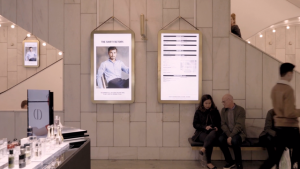As all nouns do, the meaning of the words “digital signage” adapts as the world around it changes. In its earliest days, the mention of it would bring forth an image of dots on an LED board to the mind of anyone who’d hear it. Its purpose was to display basic information such as time, dates, or any primarily text based advertisement which could fit into a single sentence. Today, that image is quite different.
Those dots are now larger in number, technology and content are both richer, and uses are more diverse than ever. It’s more affordable, accessible, and thus evolves a lot quicker. With this in mind, let us take a look at what these words mean today in 2019, 53 years after the first commercial LED sign was announced.
A tool for the customer experience
The customer experience is without a doubt the main driving factor behind enhancements done on digital signage. Yes, there are plenty of uses for other audiences. Employees, managers, researchers and companies can all benefit from digital signage in many ways. But its main purpose is communicating with the customer. Based on all trends expected to come around by the end of 2019, it is clear as day the industry continues focusing on the customer experience.
In recent years, elements such as interactivity and personalization have been on the rise. Be it through something as simple as a touchscreen, or something as futuristic as artificial intelligence, the customer experience is elevated each year. Touchscreens cover a variety of uses, and AI brings unique features such as the ability to provide advanced customer service and take interaction to a higher level.
Take a retail store as an example. It is now possible for customers to see the full inventory of the store through kiosks or tablets, and even to order out of stock items. Such features will only grow more common in the future, making digital signage an even more integral part of a store than it already is.
Likewise, greater personalization of content or a link between physical and e-commerce store are telling examples of overall improvement on the customer experience in the future.
Impact on the visual experience
Digital signage has long since passed the stage of just being a display with content. Today, plenty of other factors come into play–especially the visual factor. A display doesn’t just need to function and display the right content, it also has to be visually appealing and complement the environment it’s in. The following is a great example of how this can be done.
Recently, Nordiska Kompaniet, a luxury retailer of Sweden, teamed up with Visual Art, a Swedish digital signage provider. Visual Art deployed over 70 displays throughout their massive store. The goal was to increase communication with customers, ensure they navigate the store and learn as much as they can about products and service.
The look was important. The digital signage needed to blend well with the marble and brass environment of the store.
“The contrast between the updated modern feeling that the screens give the store, and the brass and leather casings holding them to the walls, have allowed us to preserve the historical charm of a 100-year-old building at the same time as introducing modern, digital touches,” said Hanna Blom, head of PR for Nordiska Kompaniet. In this instance, digital signage enhanced the visual experience. Primarily as the displays were thoughtfully designed, mounted and placed.
A boost for the outdoor advertising
Let’s talk about what digital signage means to OOH or Out-of-Home advertising. As you well know, this refers to advertising outdoors, but when digital signage comes into play, new opportunities arise. In the past, outdoor advertising was defined only by static billboards, posters and ads which just stand unchanged for longer periods of time. As digital signage replaces these elements, its power opens a new door for outdoor advertising.
If outdoor advertising hadn’t evolve into its current digital form, it wouldn’t be as big as it is today. Plenty of statistics show, as does common sense, that outdoor advertising is growing because of modern capabilities digital signage offers. Digital outdoor advertising indeed CAN keep up with the world of social media and internet. Meanwhile, a massive piece of paper glued to a billboard can’t meet the success it’s digital counterpart does.
An explanation for this upkeep isn’t hard to see. It is very common for outdoor displays to adapt to the environment and the audience and display specific content. Digital signage can also allow the sharing of social media posts from the user. People can interact with the content on a display through their own mobile devices, if permitted to do so.
These abilities show that with digital signage, outdoor advertising can receive input and adapt accordingly. It also shows that the nature and power of digital signage helps outdoor advertising stay current. And helps OOH perform the way a 21st century advertising tool should!










